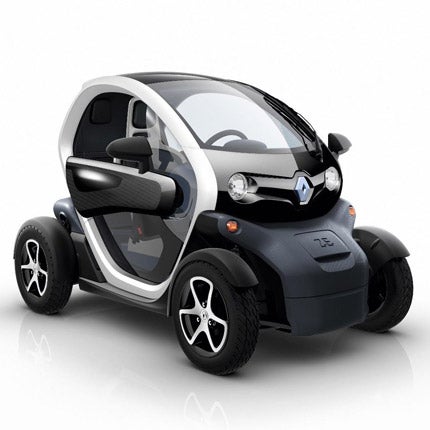Renault Twizy
Here’s how to have fun on trips around town - but make sure you can keep it charged up

Is it a car? Is it a motor scooter? Is it a go-kart with a roof? Are genres being busted here?
They are and, to twist normality even further, the Twizy is electric. And you'll be able to buy one from next March. The Twizy represents the most radical part of Renault's imminent electric-car onslaught. The Fluence saloon and Kangoo van are merely electrically-powered versions of regular vehicles, while the not-yet-launched, Zoe hatchback takes on the role of a smaller Nissan Leaf. The Twizy, however, is designed for short, quick, local journeys, maybe a station commute or sneaking in and out of city traffic.
It has four wheels and two tandem seats. The roof, plus wind-deflecting quarter windows wrapping round from the windscreen, give some weather protection. Doors which hinge upwards and forwards are optional. Accessories will include an apron to cover you up to the waist, as well as a luggage box to sit on the rear seat and an iPod/phone interface with loudspeakers. Already there's storage beneath that seat and each side of the dashboard.
Being under 4ft wide and having a 22ft turning circle, the Twizy is very handy in a tight spot. Obviously it has no emissions, and it's extremely cheap to run. It's not so cheap to buy, though; UK pricing will be around £7,000 plus £45 a month to lease the battery pack. Ah, yes ... you have to charge it up. If you live in a flat, or you have no off-street parking with power point, where do you plug it in? One day there might be roadside charging points galore, but not by next March.
Leaving this small snag aside, we'll take a closer look at the Twizy. Power comes from a rear-mounted 20bhp electric motor which drives the rear wheels. Fully charging the battery from empty takes three and a half hours, after which the Twizy is claimed to run for up to 72 miles, depending on how vigorously you drive it. Maximum vigour will see an official maximum speed of 47mph, but in practice it should edge beyond 50mph given time.
Renault regards the Twizy as an alternative to the G-Wiz electric "car", or to a secondhand supermini or to one of those three-wheeled scooter machines, but the engineering is closer to a proper miniature car. A miniature racing car, actually; it has a tubular steel chassis, a composite plastic body, a proper steering wheel, and tiny MacPherson struts in its front suspension.
Should be fun to drive, then. The example I'm about to try is a prototype, so it's less smart than production ones will be, but the driving qualities should be identical. Right arm through retractable seat-belt loop, left shoulder secured by conventional lap-and-diagonal belt. (There's also an airbag and a crushable frontal structure.) Turn the key to switch the Twizy on, press the button for forward motion, off with the handbrake, foot down and go. And go it does, with that lovely shove in the back you get in electric cars from a standing start.
It's far from silent. The axle gears whine, and you hear (and see) all the front tyres' efforts as you take your first fast bend. This happens very early in my encounter – I'm following a Renault test driver who takes the first left-hand bend at a speed surely impossible, but my Twizy hangs on gamely as the tyre treads squeal and scrub. It really is like an electric go-kart, apart from a slower steering response designed to make the 450kg Twizy easy to park and manoeuvre.
On a long straight I get to an indicated 53mph, and then come simulated urban thromboses (badly parked vans, a broken-down bus) which would defeat a regular car. The Twizy breezes through, of course. Being little wider than a large motorbike with side panniers, Twizys might in future be seen nipping between lanes of traffic or round the outside of traffic-light queues. Riots will surely ensue, questions will be asked in the House: "Is, or is not, the Renault Twizy a car?"
I can't answer that. But provided you have the means to charge its battery, I think you'll love it.
The Rivals
G-Wiz: from £8,995
Similar range, recharging time and top speed, more space, fully-glazed body, higher price, no proper safety engineering, comical looks.
Piaggio MP3 300IE LT: £5,699
Lively three-wheeled scooter with two wheels at the front. Slow, heavy and expensive hybrid version has yet to make UK price lists.
Smart ForTwo Pulse CDI: £11,860
Tiny 800cc turbodiesel makes this Smart the most economical hydrocarbon-fuelled car you can buy with just 86g/km CO2.
Subscribe to Independent Premium to bookmark this article
Want to bookmark your favourite articles and stories to read or reference later? Start your Independent Premium subscription today.

Join our commenting forum
Join thought-provoking conversations, follow other Independent readers and see their replies